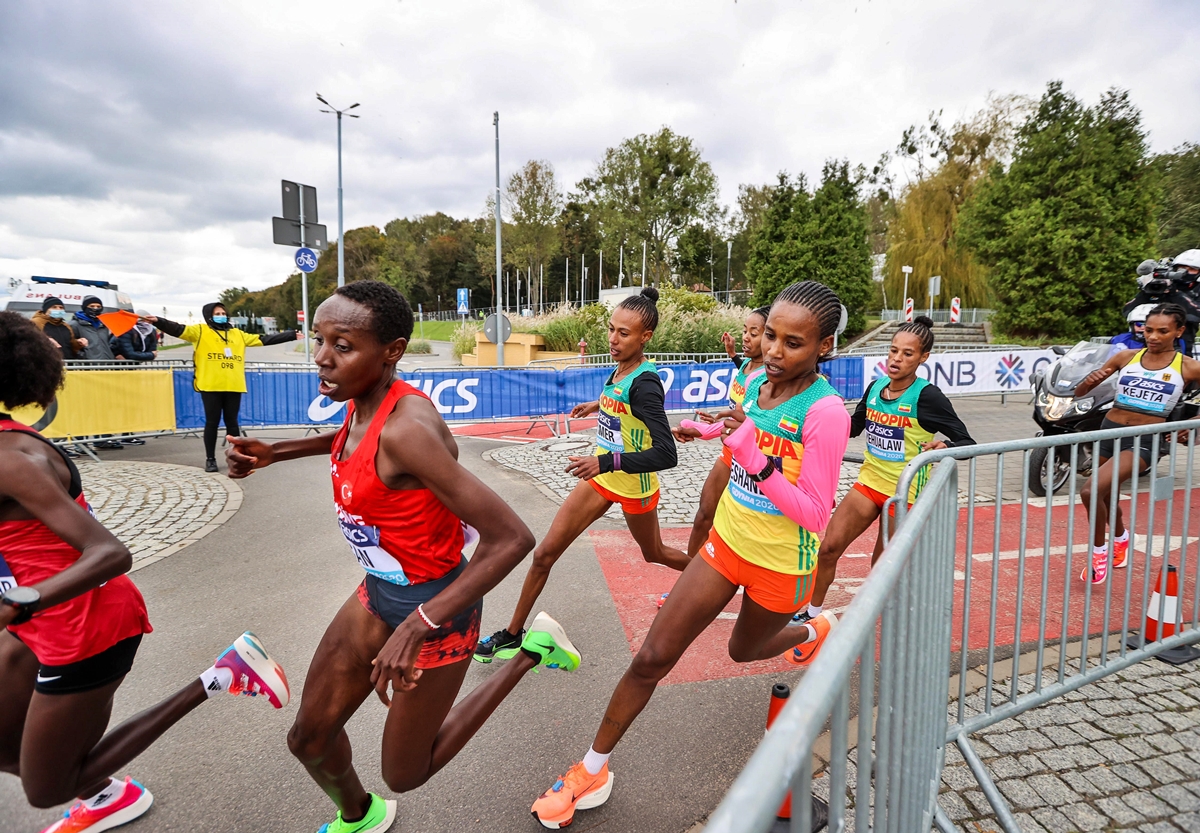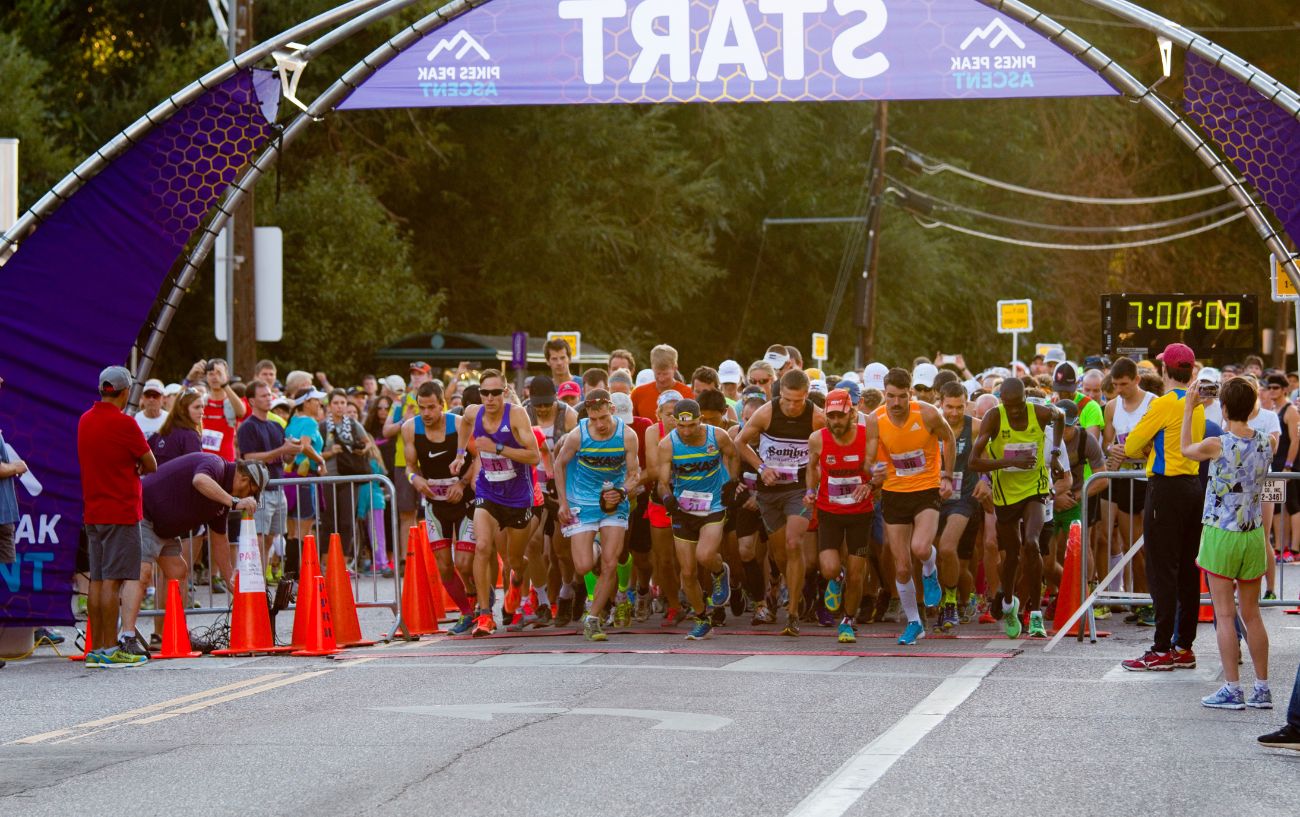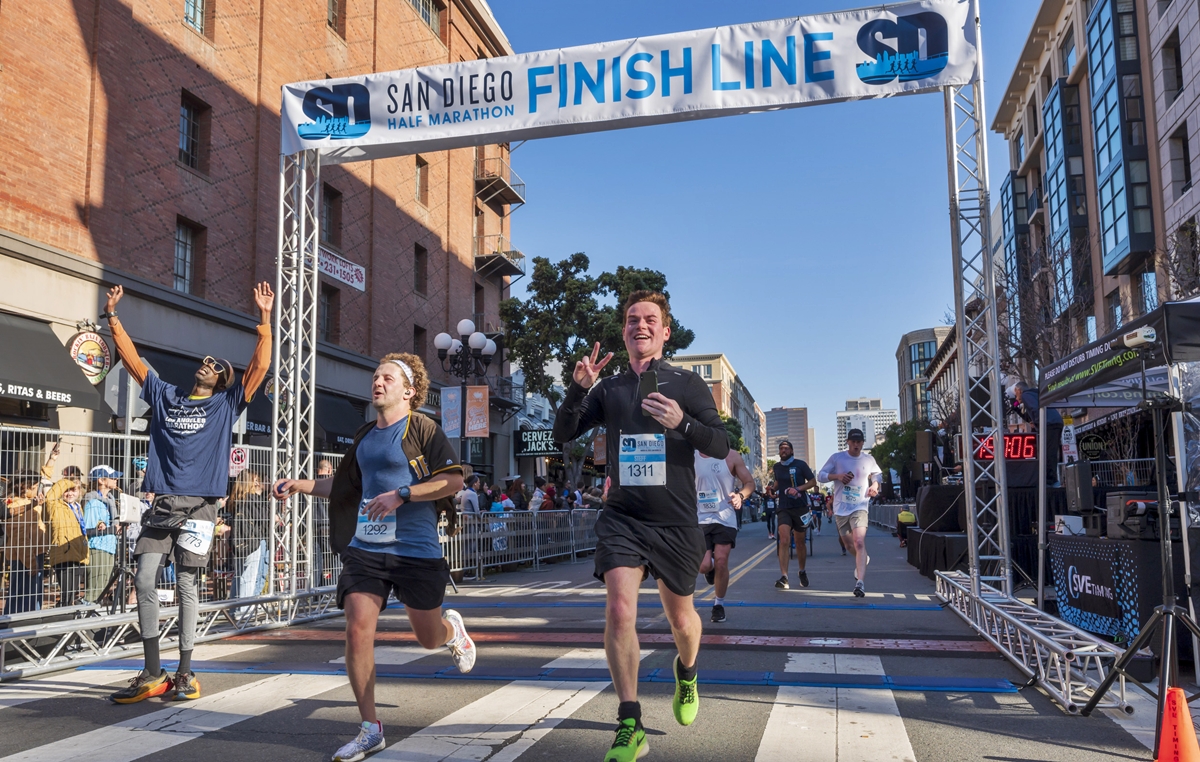

Featured
How Many Miles Is A Half Marathon
Modified: August 21, 2023
Discover how many miles make up a half marathon in this informative featured article. Get all the details you need to prepare for your upcoming race.
Introduction
Welcome to the world of half marathons! Whether you are a seasoned runner looking to challenge yourself or a beginner eager to embark on your first endurance race, the half marathon is a popular choice that offers a perfect balance between distance and intensity. In this article, we will explore the ins and outs of half marathons, uncovering everything you need to know about this exhilarating race.
A half marathon is a long-distance running race that covers a distance of 13.1 miles or 21.1 kilometers. It sits between a 10K race (6.2 miles) and a full marathon (26.2 miles) in terms of distance, making it a great stepping stone for those who want to work their way up to the full distance. The popularity of half marathons has skyrocketed in recent years, attracting both casual participants and serious runners.
Why is the half marathon distance so beloved? Well, it offers a challenge that requires training and commitment, but is also achievable for most individuals with the right preparation. It offers a thrilling sense of accomplishment and provides an opportunity to set and achieve personal goals. Plus, the training and race experience tend to be more manageable and less time-consuming compared to a full marathon.
To prepare for a half marathon, it’s important to follow a structured training plan. This will typically involve gradually increasing your running distance and incorporating speed work, long runs, and rest days into your schedule. The training process is not just about physical conditioning, but also mental fortitude. It’s a journey of self-discipline, perseverance, and pushing beyond your limits.
On race day, half marathons bring together a diverse group of individuals, all sharing a common goal of conquering the distance. The atmosphere is electric, with participants ranging from elite athletes to enthusiasts dressed in creative costumes. The energy of the crowd and the support from fellow runners can be incredibly motivating and inspiring.
Throughout this article, we will delve into the world of half marathon training, provide strategies for race day, and offer tips for a successful race. Whether you are aiming to achieve a personal best time or simply want to cross the finish line, I’m here to guide you on your half marathon journey. So, lace up your running shoes, hit the pavement, and let’s get started!
Understanding the Distance
Before you embark on your half marathon training journey, it’s important to have a clear understanding of the distance you will be covering. A half marathon spans 13.1 miles or 21.1 kilometers, making it a significant challenge for runners of all levels.
When it comes to understanding the distance, it’s helpful to break it down into manageable chunks. The race is typically divided into mile markers or kilometer markers, providing you with a sense of progress as you conquer each milestone. By mentally dividing the distance, you can set mini-goals for yourself and stay motivated throughout the race.
One key aspect to note about the half marathon distance is that it requires endurance and pacing. Unlike shorter races where the focus is on speed, the half marathon demands a balance between maintaining a consistent pace and conserving energy for the later miles. This is especially crucial for beginners, as starting too fast can lead to burnout before reaching the finish line.
It’s also important to consider the terrain and elevation of the course when understanding the distance. Half marathons can take place on various types of terrain, including roads, trails, or a combination of both. Some courses may have challenging uphill segments or downhill stretches that can impact your pacing and energy levels. Familiarize yourself with the course profile beforehand to better prepare mentally and physically.
Additionally, the weather conditions on race day can play a significant role in your performance. Heat, humidity, and strong winds can pose additional challenges, so it’s important to adjust your strategy and pace accordingly. Proper hydration and wearing appropriate clothing can help you navigate through different weather conditions.
Lastly, it’s important to approach the half marathon distance with a positive mindset. Understand that there will be ups and downs during the race, both physically and mentally. Embrace the journey and remind yourself of the dedication and training you have put into reaching this point. It’s normal to experience fatigue, doubt, or even moments of pain, but remember that the sense of accomplishment and pride that comes from crossing the finish line will be worth it all.
Now that you have a deeper understanding of the half marathon distance, you can approach your training and race day with confidence. In the next section, we will explore the essential aspects of half marathon training to help you prepare effectively for the race.
Half Marathon Training
Preparing for a half marathon requires a comprehensive training plan that focuses on building endurance, strength, and speed. By following a structured training program, you can gradually increase your fitness level and prepare your body for the rigors of the race.
Here are some key points to consider when embarking on your half marathon training:
1. Establish a Training Schedule: Set a consistent training schedule that fits into your lifestyle. Determine the number of days per week you can dedicate to running and allocate rest days to allow your body to recover. Consistency is key in building stamina and strength.
2. Gradually Increase Mileage: Start with a base mileage that is comfortable for you and gradually increase it over time. Aim to add about 10% to your total weekly mileage each week. This gradual progression helps prevent injuries and allows your body to adapt to the increased mileage.
3. Incorporate Different Types of Runs: Vary your training runs to include long runs, tempo runs, interval training, and easy recovery runs. Long runs help build endurance, tempo runs improve your speed, interval training enhances your cardiovascular fitness, and easy runs aid in recovery.
4. Strength Training and Cross-Training: Incorporate strength training exercises into your routine to strengthen your muscles, improve your running form, and prevent imbalances or injuries. Additionally, cross-training activities like swimming, cycling, or yoga can provide a break from running while still maintaining overall fitness.
5. Rest and Recovery: Rest days are just as crucial as training days. They allow your body to recover, repair muscles, and prevent overuse injuries. Listen to your body and don’t be afraid to take rest days when needed.
6. Pay Attention to Nutrition and Hydration: Fueling your body properly is essential for optimal performance during training and on race day. Maintain a balanced diet that includes carbohydrates, proteins, healthy fats, and plenty of fruits and vegetables. Hydration is equally important, so drink enough water throughout the day and during your runs.
7. Practice Race Day Strategies: During your training, simulate race day conditions by practicing your race day strategies. This includes testing out your race gear, fueling strategies, and pacing techniques. It will help you fine-tune your approach and build confidence for the actual race.
Remember, every runner is unique, and it’s important to listen to your body throughout the training process. If you experience any pain or discomfort, it’s best to address it promptly rather than push through and risk further injury.
By following a well-rounded training plan that includes these key elements, you will increase your chances of not only crossing the finish line but also achieving your personal best time. In the next section, we will discuss strategies to ensure a successful race day.
Strategies for Race Day
Race day is the culmination of your hard work and training. To make the most of your half marathon experience, it’s important to develop strategies that will help you tackle the race with confidence and efficiency. Here are some key strategies to consider:
1. Pace Yourself: It’s crucial to start the race at a pace that you can sustain throughout the entire distance. Resist the temptation to go out too fast, as this can lead to early fatigue and make the later miles much more challenging. Trust your training and stick to your planned pace.
2. Familiarize Yourself with the Course: Study the course map and elevation profile beforehand to have a clear understanding of what to expect. Identify any challenging parts of the course and plan your race strategy accordingly. Knowing when to conserve energy and when to push through can make a significant difference in your overall performance.
3. Stay Hydrated and Fuel Up: Proper hydration and fueling during the race are essential for maintaining energy levels and preventing dehydration. Take advantage of aid stations along the course to drink water or sports drinks, and consider carrying energy gels or snacks to replenish your energy stores as needed.
4. Break the Race into Segments: Mentally divide the race into smaller segments or milestones to make it more manageable. Focus on reaching one segment at a time rather than overwhelming yourself with the entire distance. Celebrate each milestone you reach, and use it as motivation to push forward.
5. Listen to Your Body: Pay attention to any signs of fatigue, discomfort, or pain during the race. While it’s normal to experience some level of discomfort, it’s important to distinguish between normal race discomfort and potential injury. If necessary, adjust your pace, take short walking breaks, or seek medical assistance if you’re in significant pain.
6. Utilize Mental Strategies: Long-distance races can be mentally challenging, so it’s helpful to have mental strategies in place to stay focused and motivated. Use positive self-talk, visualization techniques, or distraction methods, such as focusing on the scenery or cheering crowds, to keep your mind engaged and ward off negative thoughts.
7. Embrace and Enjoy the Experience: Remember that the half marathon is not only about achieving a specific time but also about celebrating your achievement and enjoying the experience. Soak in the atmosphere, interact with fellow runners, and take in the sights and sounds along the course. Smile, wave to the spectators, and embrace the incredible journey you are undertaking.
By implementing these strategies on race day, you will be better equipped to face any challenges that arise and maintain a positive mindset throughout the race. Your training and preparation will shine through as you push yourself to new heights. In the next section, we will provide additional tips to help you have a successful half marathon.
Tips for a Successful Half Marathon
As you approach your half marathon, it’s essential to arm yourself with additional tips and strategies that can elevate your race experience and increase your chances of success. Here are some key tips to keep in mind:
1. Get Adequate Rest: In the days leading up to the race, prioritize restful sleep to allow your body to recover and recharge. Avoid strenuous activities or intense workouts to prevent fatigue or muscle soreness on race day.
2. Dress Appropriately: Select comfortable and moisture-wicking clothing that suits the weather conditions on race day. Avoid wearing anything new or unfamiliar, as it may cause discomfort or chafing during the race. Opt for well-fitting running shoes that provide proper support and cushioning.
3. Arrive Early: Plan to arrive at the race venue well in advance to avoid any last-minute stress. This will give you ample time to use the restroom, warm-up, and familiarize yourself with the race logistics.
4. Start Slow and Finish Strong: Begin the race at a conservative pace that allows you to conserve energy for the later miles. As you approach the final miles, pick up your pace and finish strong. This strategy will help you maintain energy levels and achieve a strong finish.
5. Hydrate Strategically: Take advantage of the water and fluid stations along the course, but avoid drinking large amounts at once. Sip small amounts of water or sports drinks regularly to stay hydrated without causing discomfort or stomach issues.
6. Fuel Properly: Practice your fueling strategy during training to determine what works best for you. If using energy gels or snacks during the race, take them with water to aid digestion. Consider incorporating a mix of carbohydrates, electrolytes, and a small amount of protein to sustain your energy levels.
7. Maintain Good Form: Focus on maintaining proper running form throughout the race. Keep your head up, shoulders relaxed, and arms swinging naturally. Avoid slouching or leaning forward too much, as this can lead to inefficient running mechanics and fatigue.
8. Have a Support System: If possible, have family or friends cheer you on at various points along the course. Their support can provide an extra boost of motivation and encouragement when you need it most.
9. Stay Positive: Mental strength plays a vital role in a successful half marathon. Stay positive, believe in your training, and embrace any challenges that come your way. Celebrate small victories and maintain a strong mindset throughout the race.
10. Reflect and Celebrate: After crossing the finish line, take the time to reflect on your achievement. Regardless of your finishing time, completing a half marathon is a significant accomplishment. Celebrate your hard work, determination, and commitment to reaching your goal. Be proud of yourself!
By incorporating these tips into your race day preparations, you’ll set yourself up for a successful and enjoyable half marathon experience. Remember that every race is a learning experience, and each one is an opportunity to grow as a runner. So, go out there with confidence, give it your all, and revel in the joy of completing a half marathon.
Conclusion
Congratulations! You have now gained a comprehensive understanding of the half marathon distance, training methods, race day strategies, and tips for success. You are well-equipped to embark on your half marathon journey, whether you’re aiming for a personal record or simply aiming to cross the finish line with a sense of accomplishment.
Remember, the half marathon is not just about the physical aspect of running but also about the mental strength and determination to push through challenges. The training process will require commitment, discipline, and resilience, but the rewards are immeasurable.
Throughout your training, ensure you have a well-structured plan that gradually increases your mileage, incorporates various types of runs, and allows for proper rest and recovery. Listen to your body, stay hydrated, and fuel yourself with the appropriate nutrients.
On race day, pace yourself, visualize success, and soak in the atmosphere. Break the race down into manageable segments, stay positive, and utilize strategies that work best for you. Remember to embrace the experience and enjoy the journey, as crossing the finish line is a remarkable achievement, regardless of your finishing time.
As you reflect on your half marathon journey, be proud of your dedication and hard work. Celebrate your accomplishments, learn from the challenges, and continue setting new goals. Whether this is your first half marathon or one of many, each race is a unique opportunity for growth and personal development.
Now, lace up your running shoes, embark on your training plan, and get ready to conquer the half marathon distance. Good luck on your journey, and may the road ahead be filled with excitement, fulfillment, and unforgettable moments. You’ve got this!









